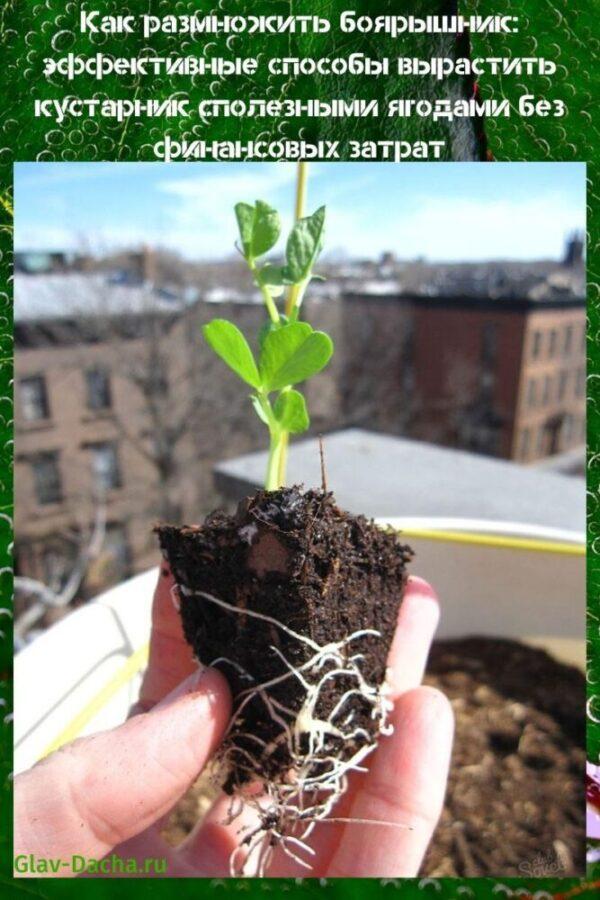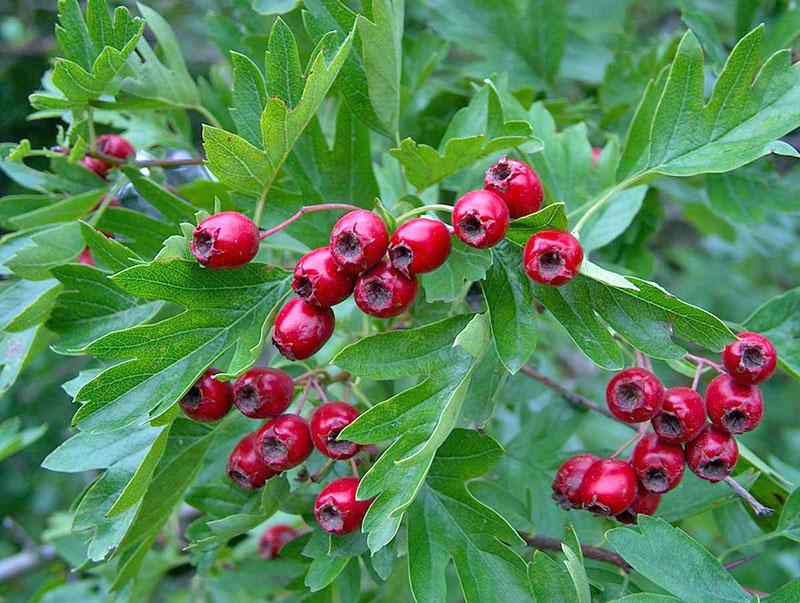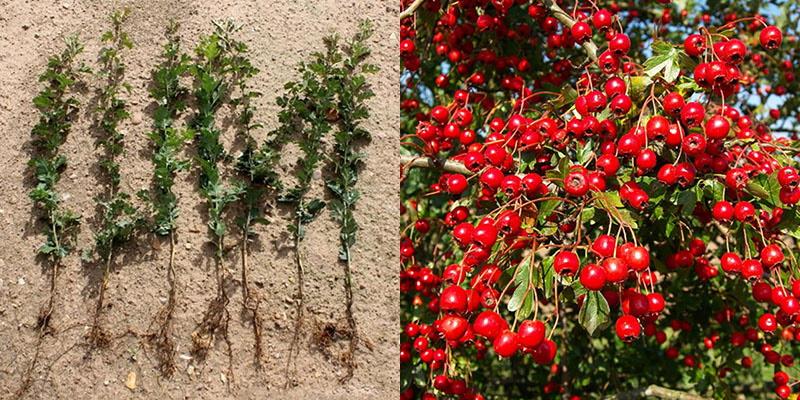How to propagate hawthorn: effective ways to grow a shrub with healthy berries without financial costs
 In the middle of summer, hawthorn, a beautiful shrub covered with blood-red, orange berries, ripens in gardens and orchards. Many people want to grow it at home, but do not know how to propagate a hawthorn, they think that they need to buy expensive seedlings. But you can grow a shrub on your own, without special knowledge and experience.
In the middle of summer, hawthorn, a beautiful shrub covered with blood-red, orange berries, ripens in gardens and orchards. Many people want to grow it at home, but do not know how to propagate a hawthorn, they think that they need to buy expensive seedlings. But you can grow a shrub on your own, without special knowledge and experience.

How to propagate hawthorn: common methods
 To breed a bush, gardeners use many methods. Some are lighter, but not effective enough, others are laborious, but give a 100% guarantee of the survival rate of a young plant, provided that all the rules are followed.
To breed a bush, gardeners use many methods. Some are lighter, but not effective enough, others are laborious, but give a 100% guarantee of the survival rate of a young plant, provided that all the rules are followed.
Layers
 The method is used to rejuvenate shrubs. Before rooting the hawthorn with this method, it is first pruned to stimulate the growth of new shoots. The next year, the soil under the bushes is fertilized with humus. In the spring, after the snow melts, one-year-old shoots are laid horizontally in shallow trenches dug nearby, without separating them from the mother bush. They are fixed to the ground with wire loops, especially at the base, so that the shoot develops its own root system. Sprinkle with soil, mulch, leaving the upper edge free.
The method is used to rejuvenate shrubs. Before rooting the hawthorn with this method, it is first pruned to stimulate the growth of new shoots. The next year, the soil under the bushes is fertilized with humus. In the spring, after the snow melts, one-year-old shoots are laid horizontally in shallow trenches dug nearby, without separating them from the mother bush. They are fixed to the ground with wire loops, especially at the base, so that the shoot develops its own root system. Sprinkle with soil, mulch, leaving the upper edge free.
Care rules:
- Water it regularly, add a one percent solution of ammonium nitrate to the soil, make sure that the cuttings are not exposed, filling it with soil as needed.
- As soon as young shoots appear, hilling is carried out every 2 weeks.
- In the fall, the cuttings will develop a powerful root system, then they are removed from the mother bush.
- If the roots are weak, the plants are left in the same place until next year.
The transplanted layers are grown for 4 years, regularly watering, loosening, applying fertilizers based on nitrogen.
Seeds
 Seed propagation of hawthorn is a simple, natural, but ineffective way. If you wait until the seeds ripen, they will fall off and a bush will grow out of them, it will take 2-4 years. When ripe, the outer shell of the berries becomes very dense, which prevents rapid germination. Therefore, it is recommended to harvest seeds from slightly unripe fruits.
Seed propagation of hawthorn is a simple, natural, but ineffective way. If you wait until the seeds ripen, they will fall off and a bush will grow out of them, it will take 2-4 years. When ripe, the outer shell of the berries becomes very dense, which prevents rapid germination. Therefore, it is recommended to harvest seeds from slightly unripe fruits.
When propagating by seeds, the shell is cut, the berries with pulp are soaked in water for a day. Remove and rub through a sieve. The separated grains are soaked in 1% potassium nitrate for a day. Then they are placed in a container with warm water and kept for 3-6 days.
Carry out stratification in a cold and warm way. Prepare wooden boxes with drainage holes, on the bottom of which cheesecloth is laid in several layers. Seeds are placed on it.
First, they are kept at a temperature of +20 ° C and good humidity for 4 months. Then a period of cold stratification sets in, when the boxes with seeds are taken to the cellar or to a closed loggia, where the average temperature is kept at around + 6 ° C. Leave there for 3-6 months.
 The stratified planting material is planted in the soil in the fall. All plantings must be mulched with spruce branches, humus, compost or sawdust so that the seeds do not freeze and start growing faster. Young shoots of hawthorn should appear next summer.
The stratified planting material is planted in the soil in the fall. All plantings must be mulched with spruce branches, humus, compost or sawdust so that the seeds do not freeze and start growing faster. Young shoots of hawthorn should appear next summer.
How to propagate hawthorn by cuttings
 One of the popular ways to propagate shrubs. For beginner gardeners, this method seems to be the easiest for breeding hawthorn, but it has its own characteristics associated with the choice of planting material.
One of the popular ways to propagate shrubs. For beginner gardeners, this method seems to be the easiest for breeding hawthorn, but it has its own characteristics associated with the choice of planting material.
The cuttings must meet the following parameters:
- age 1-2 years;
- without damage;
- thickness 7-8 mm.
The hawthorn is propagated by green cuttings, since the lignified ones root poorly. The material for vegetation is cut from the middle of the bush, closer to the southern part of the crown. They choose shoots that grow not upwards, but sideways. Their root system develops better. The branch is cut very close to the base under the buds, where the tissues are more protected from the penetration of mycobacteria. Divide them into pieces of 10-15 cm, cutting with a sharp knife in the center of internodes. All cuttings are cut from above at an angle of 45 degrees, as close to the bud as possible.
Since the tops of the shoots take a very long time and root poorly, not very long shoots are cut off. Some gardeners choose the tallest branches and cut them into a large number of pieces. In this case, only cuttings that are closer to the base take root.
Before propagating the hawthorn by cuttings, place them in a nutrient solution with an added root growth stimulant. It is kept in it for an hour. They are planted in a sand-peat mixture, watered with a root-forming composition, covered with glass jars to create greenhouse conditions. When leaf blades appear, the banks are removed daily for 15 minutes to adapt the seedlings. Regularly, the time of their stay in the fresh air is increased. Water abundantly, focusing on the drying of the upper layer of the soil mixture. They are fed with nitrogenous fertilizers.
Many gardeners root cuttings in potato tubers. To do this, choose healthy potatoes, cut off their eyes, make a hole in the middle and insert a stalk into it, place them in the ground. In the tuber, he receives all the necessary nutrients and water.
When the bushes have a powerful root system, they are transplanted in a checkerboard pattern in open ground, leaving a distance between plants of more than 2 meters, between rows - 4 meters. In the fourth year, the bushes are transplanted to larger areas.
Root offspring
 Before propagating the hawthorn by root offspring, make sure that the bush variety is capable of producing young shoots. The offspring are spread up to 30 cm from the mother bush. After the first wintering, the shoots turn green and grow actively. As soon as it reaches a height of 10 cm, it is separated. It is advisable to do this before July so that young plants do not take nutrients from the mother bushes. Dig out the shoots as carefully as possible, together with a lump of earth, without damaging the roots. The root of the mother bush is not pulled, the offspring are carefully cut off from it with pruning shears.
Before propagating the hawthorn by root offspring, make sure that the bush variety is capable of producing young shoots. The offspring are spread up to 30 cm from the mother bush. After the first wintering, the shoots turn green and grow actively. As soon as it reaches a height of 10 cm, it is separated. It is advisable to do this before July so that young plants do not take nutrients from the mother bushes. Dig out the shoots as carefully as possible, together with a lump of earth, without damaging the roots. The root of the mother bush is not pulled, the offspring are carefully cut off from it with pruning shears.
To prevent the roots from drying out, the young hawthorn is immediately planted in the soil in a permanent place.
Root cuttings
 The most effective way to breed hawthorn. Root cuttings take root well, grow quickly. The method is well suited for breeding varieties with large berries. If hawthorn propagation is carried out by cuttings in the fall, cuttings 15 cm long are cut from the root system. They are placed in the soil obliquely and mulched more efficiently so that they can survive the cold.
The most effective way to breed hawthorn. Root cuttings take root well, grow quickly. The method is well suited for breeding varieties with large berries. If hawthorn propagation is carried out by cuttings in the fall, cuttings 15 cm long are cut from the root system. They are placed in the soil obliquely and mulched more efficiently so that they can survive the cold.
In spring breeding, the shrub is carefully dug up, the roots are cleaned of the earth and cut into pieces of 8 cm long. Each root is buried in soil, leaving about 2 cm on the surface.Mulched with sawdust, hay or straw, covered with plastic bottles to prevent moisture evaporation.
How hawthorn is propagated by grafting (budding)
 Before planting a hawthorn, you should know that only its garden varieties are propagated this way. This is done in several ways. The simplest is copulation, after which the cuttings take root with a 100% guarantee. The branches of the stock and scion are cut at an angle of 30 degrees, applied, pressed and rewound with plastic wrap or electrical tape so that moisture does not get on the cut.
Before planting a hawthorn, you should know that only its garden varieties are propagated this way. This is done in several ways. The simplest is copulation, after which the cuttings take root with a 100% guarantee. The branches of the stock and scion are cut at an angle of 30 degrees, applied, pressed and rewound with plastic wrap or electrical tape so that moisture does not get on the cut.
The thickness of the rootstock and the scion for copulation should be the same so that the cut areas are as close to each other as possible.
Another method of grafting is in cleavage. At the rootstock, the upper part of the branch is cut off. The remainder is cut 5 cm deep. A scion stalk with at least 3 buds is inserted there. Previously, the lower side of the scion is sharpened so that it fits more easily into the cut.
Very similar to cleft grafting in the butt. In this case, an incision in the rootstock is made on the lateral side of the rootstock branch. A stalk is inserted into it. The places of the cut are treated with garden varnish, wrapped with cellophane, but not too much so that the scion does not dry out.
 As the scion and rootstock grow together, the hawthorn is provided with high-quality watering, top dressing, pest treatment, and protected from direct sunlight. The success of the vaccination is judged in a month, when buds and shoots appear on the scion. The bandage is loosened, but it is removed only when the vaccination site is overgrown.
As the scion and rootstock grow together, the hawthorn is provided with high-quality watering, top dressing, pest treatment, and protected from direct sunlight. The success of the vaccination is judged in a month, when buds and shoots appear on the scion. The bandage is loosened, but it is removed only when the vaccination site is overgrown.
To improve the taste of hawthorn and its beneficial properties, cherries, pears, apple trees, dogwoods, and red mountain ash are grafted onto it. With the help of grafting, old, weakly fruiting bushes are revived, which after the procedure again begin to produce tasty berries.
Plants are grafted in early spring or late autumn. Cuttings intended for scion are harvested in the fall and stored in a cool place. During vaccination, they should have at least 4 well-developed, dense buds.
When breeding a shrub for the first time, the instructions are followed as clearly as possible in order to understand the basic principle of the chosen method. In the future, the plant is propagated, focusing on their experience.